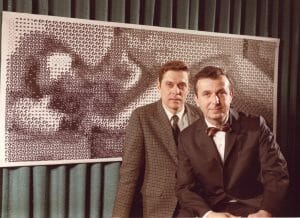Born on his family’s farm in eastern New York, Knowlton was precocious: he graduated a year early from high school and still made valedictorian. He went to Cornell University, where his parents had met, for a 5-year program in engineering and physics; he stayed at Cornell to complete a Master’s degree in the same subjects. For his thesis, he modified an RCA electron microscope to work as an X-ray microscope. Then it was on to MIT for his Ph.D, after which he was quickly snapped up by one of the premier scientific research institutes of the time, Bell Telephone Labs — the research arm of the phone company. At Bell Labs in 1963, Knowlton developed a new programming language to support one of his interests: art. “BEFLIX” (for Bell Flicks) was the first language specific to generating computer-driven animation. One of the first uses, of course, was to make a film to describe the process (included below: a bit slow and ponderous, as things often were in the early 60s). It used a microfilm recorder to record dots on a cathode ray tube screen with a resolution of 252×184 in 8 shades of gray. “He was the first man to fill a movie screen with pixels,” says computer science pioneer Ted Nelson. “Now, every movie you see was created on a digital machine.”

In 1966 he and colleague Leon Harmon applied the same general technique, but using various computer-generated characters to approximate different shades of gray, and print the results on the computer’s paper line printer. Their first subject? The usual: “Computer Nude (Studies in Perception)” — a digitized photo of dancer Deborah Hay (still alive today at 91). The result, generated by an IBM 7094 computer, was 12 feet wide, and they posted it on their boss’s office wall. Bell Labs’ Executive Director of Communications Research, Edward David Jr., was anything but pleased, but the image inspired pop artist Robert Rauschenberg to launch a non-profit institute to mix engineers with artists to help artists use technology to create art: Experiments in Art and Technology (EAT). The New York Times covered EAT’s opening (11 October 1967), illustrated by a photo of the printed mosaic — the first time ever that newspaper ran an image of a full-frontal nude woman. The original was eventually lost, but Knowlton supervised a recreated version in 2016.
How they got there was interesting: “Bell Labs, you know, free as they were, the [public relations] department said, yes you can publicize this, but please just be — sort of soft pedal it under that it was made at Bell Labs. Do not mention that it was made at Bell Labs, you did it as individuals somewhere,” Knowlton recalled in 1988. “Then… it appeared on the first page of the second section of The New York Times, and that made it art, with a capital A. And bless them, the people in the PR department said yes, you can go on and publish this, but henceforth, please be sure that people know that it was made at Bell Labs.” Sure enough, it is Art: a half-size version is on display at the Albright-Knox Gallery in Buffalo, New York. Knowlton left Bell Labs for Wang Laboratories in 1982, helping to develop the company’s personal computers, and he retired in 2008 — to be an artist himself, creating mosaics not just on computers, but with (especially) sea shells and other physical objects, which were exhibited in dozens of shows. Kenneth Charles Knowlton died in Sarasota, Fla., on June 16. He was 91.
